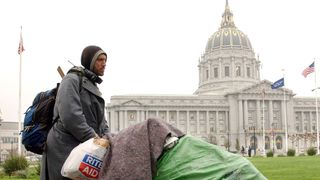In San Francisco, a household that makes US$100,000 per year is considered low-income. A studio apartment there rents for about AU$850 per week. In Cupertino, home of Apple headquarters, the median home value is well over US$2 million. This is the natural consequence of a metropolis that revolves around the economic gravity of Silicon Valley. The Bay Area, as a whole, is one of the richest regions in the United States, but because of some conceptual quirks, it doesn’t appear to be so unequal on the surface. The full picture of urban inequality depends on who counts and who is counted.
Cities around the world are importing more than just kitsch Americana; they’re importing inequality.
In June of this year, I attended the Chicago Forum on Global Cities as the delegate for the United States Studies Centre. For the geographically astute, you can imagine that a few eyebrows were raised when a master’s student from Sydney explained they were in Chicago to learn about material inequality in the Bay Area. This is because the greatest challenges facing the world’s big cities are local manifestations of common and global issues. Major cities are the gateways of globalisation. They have more in common with each other than with the rest of their countries. If you ever want to know where the global epicentre of any world city is, simply follow the tourist foot traffic until you hit the obligatory Hard Rock Café. You can be assured that the authentic local flavour will increase linearly with distance from that spot.
But cities around the world are importing more than just kitsch Americana; they’re importing inequality. The most successful cities will attract professionals, investors, and hopefuls from a global pool of talent and, if not equitably managed, the intense competition for space — both economic and physical — will cause these urban populations to segregate according to their means.
In the 1970s, human capital was more or less equally distributed across US cities. No city in America was disproportionately better paid than another. But since then, poorer and less educated Americans have been leaving the fastest growing US cities, while places like Silicon Valley have thrived on new blood through the influx of skilled migration. San Francisco is now in the lead for average wealth and its absurdly expensive cost of living reflects it. Other cities have rich people, but no city has as many rich people as San Francisco. This is why inequality is an insufficient metric to characterise what is going on. The elimination of the poor from the sample is the surest way to solve the inequality problem.
If urban inequality is not evident within cities, then it’s likely because over the last few decades it has been moving between cities.
When urbanist Alex Schafran sought to describe how inequality hides within the gaps and behind the boundaries of the Bay Area’s fragmented urban geography, he wrote: “There is a deep tendency in America to assume problems evident in geography are the result of choices, decisions, and events made primarily in that geography as opposed to inequalities and poor decision-making in the wider system of urban and regional development.” Downtown Chicago was a pristine oasis of modernity, but it was built on the exclusion and concentration of poor African-Americans swept underneath its urban rug. San Francisco is much too expensive and instead exports its poor people. If urban inequality is not evident within cities, then it’s likely because over the last few decades it has been moving between cities.
The most disadvantaged members of society are the least visible and we need better ways of including them within our conceptual frameworks of inequality. San Francisco has the most unsheltered homeless people of any US city, and those who are sheltered—doubled up in the homes of friends, or temporarily residing within institutions like jail—are not even counted in the homeless census that only takes place every second January.
Urban poverty is being reinforced by a poverty of data and imagination. There needs to be a concerted effort to rethink the ways we conceive inequality because we cannot devise solutions to problems we struggle to perceive.
Inequality pervades the conformity of a seemingly universally rich and rosy San Francisco. People are struggling to get by on six-figure salaries and homeless people are filling the streets of the wealthiest and most progressive city in America. If everyone is rich, no one is, and then how will the poorest amongst us be seen?





